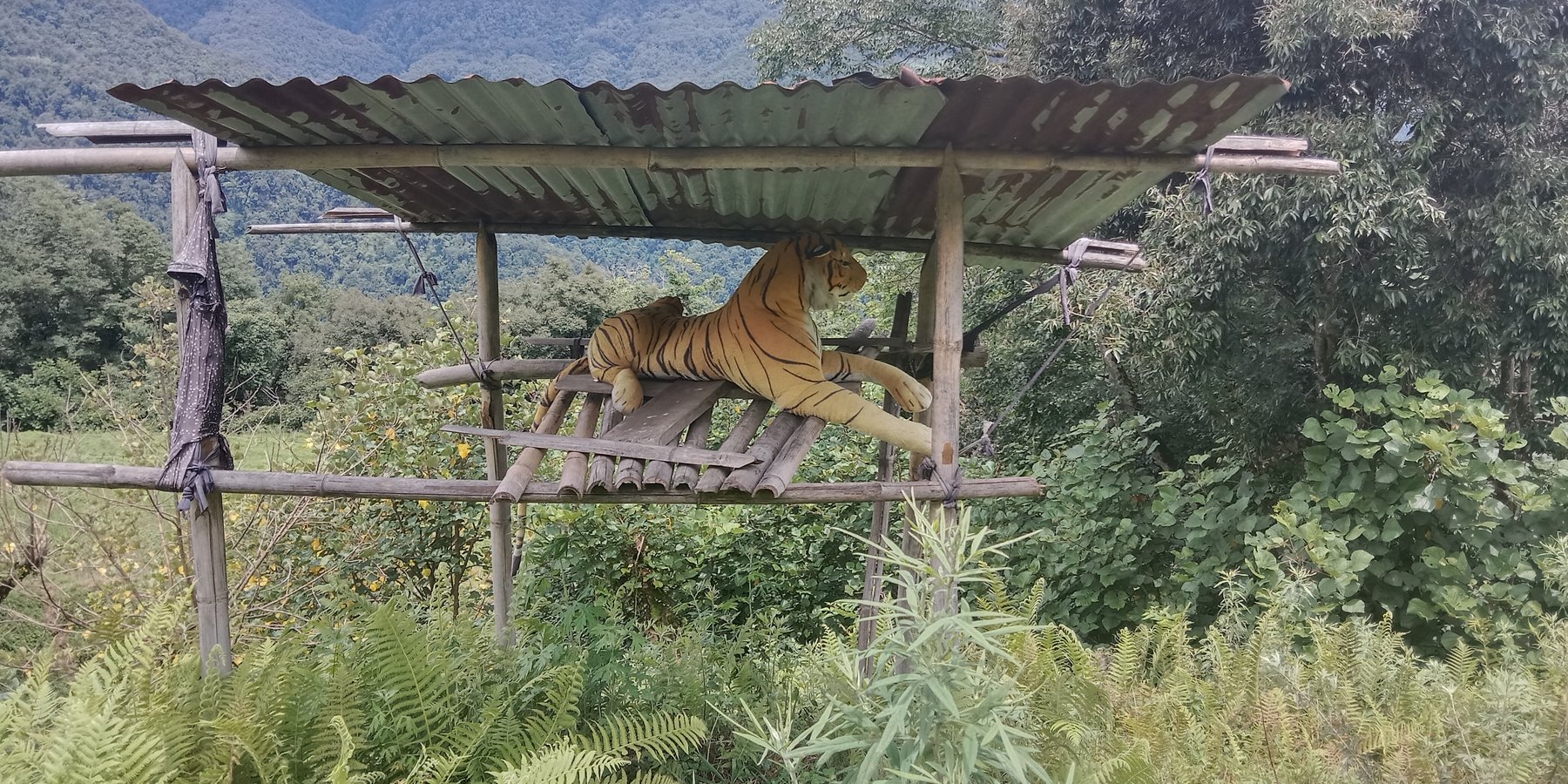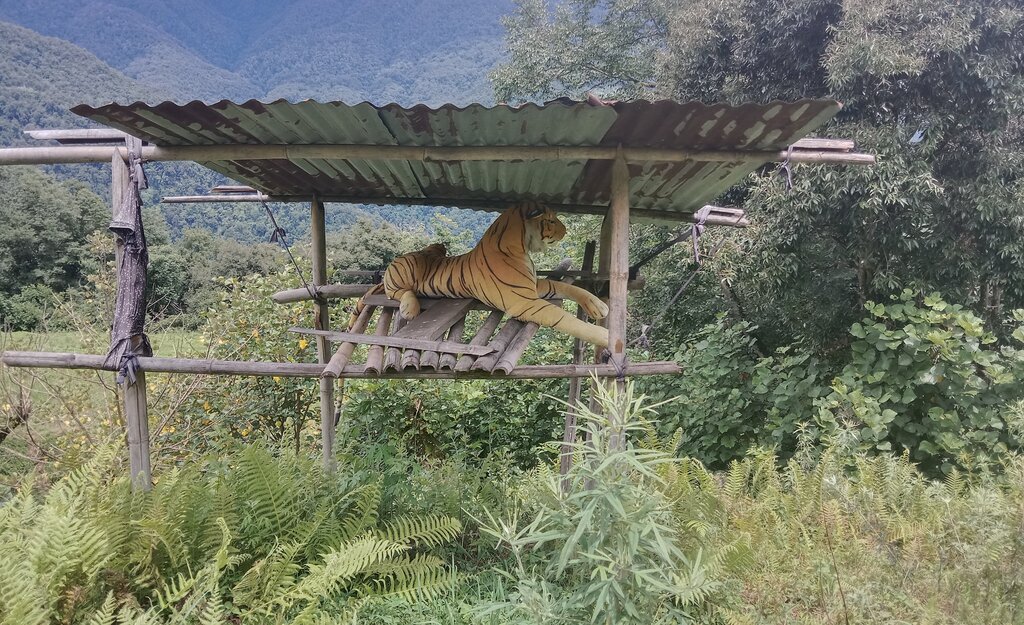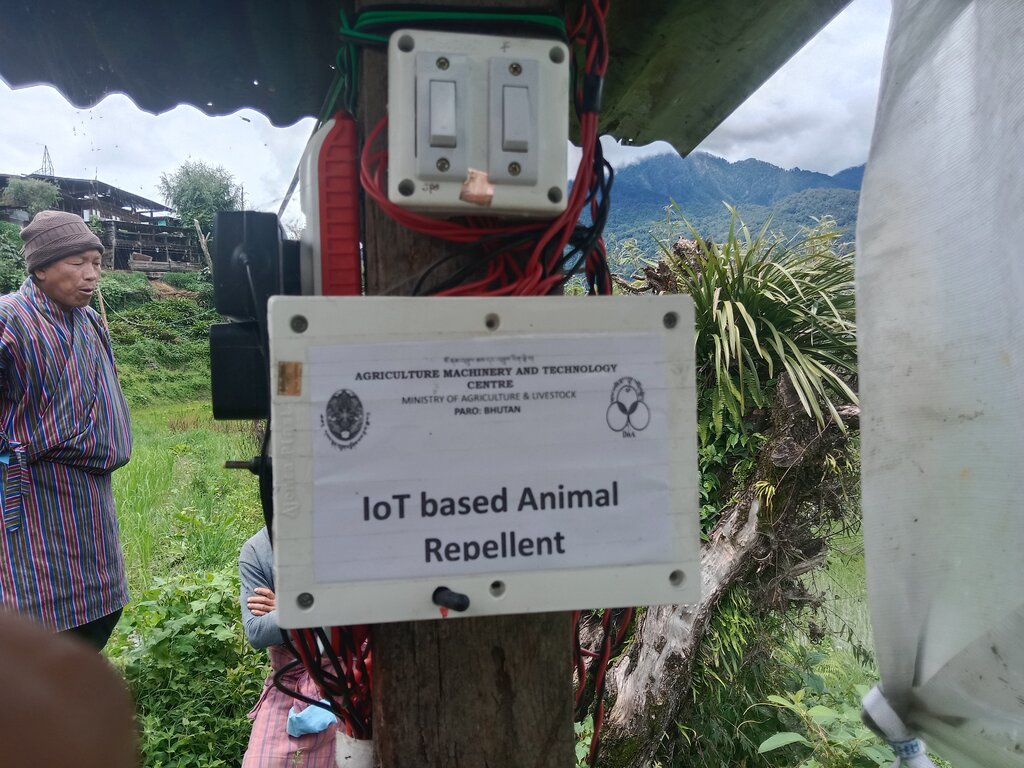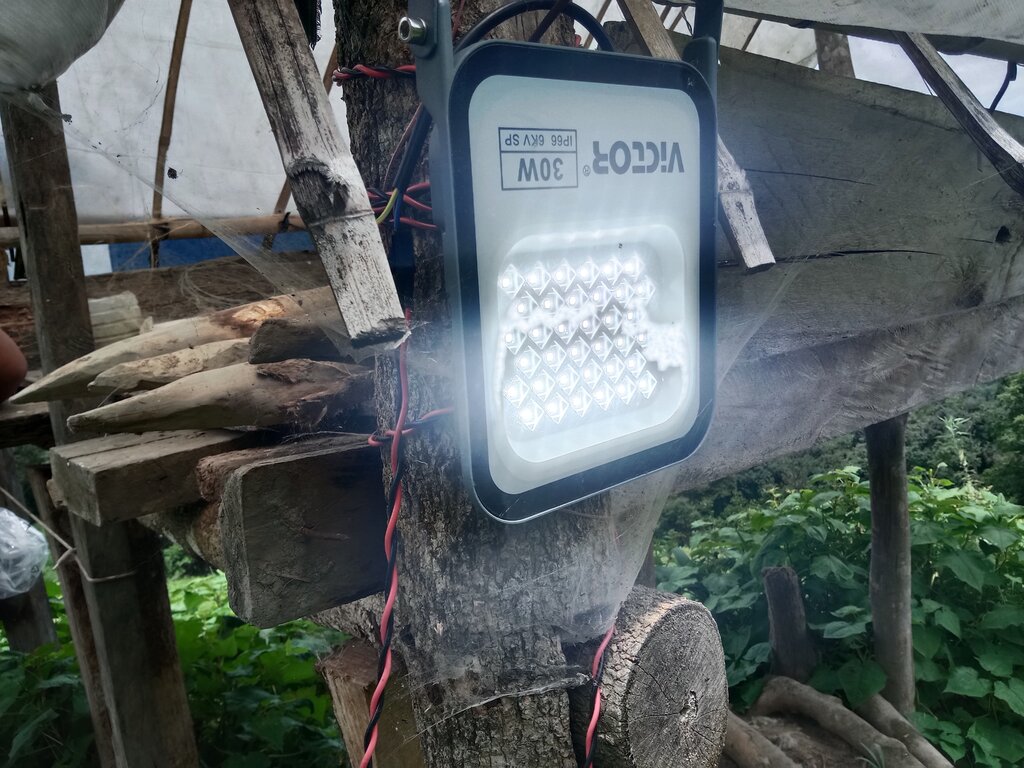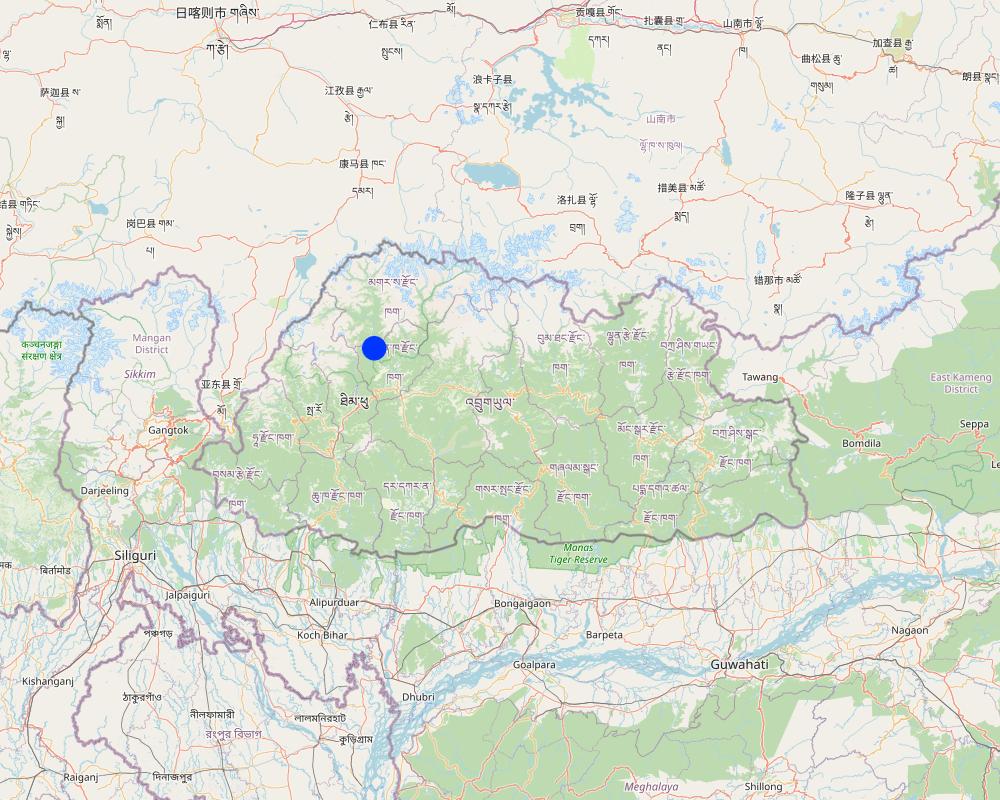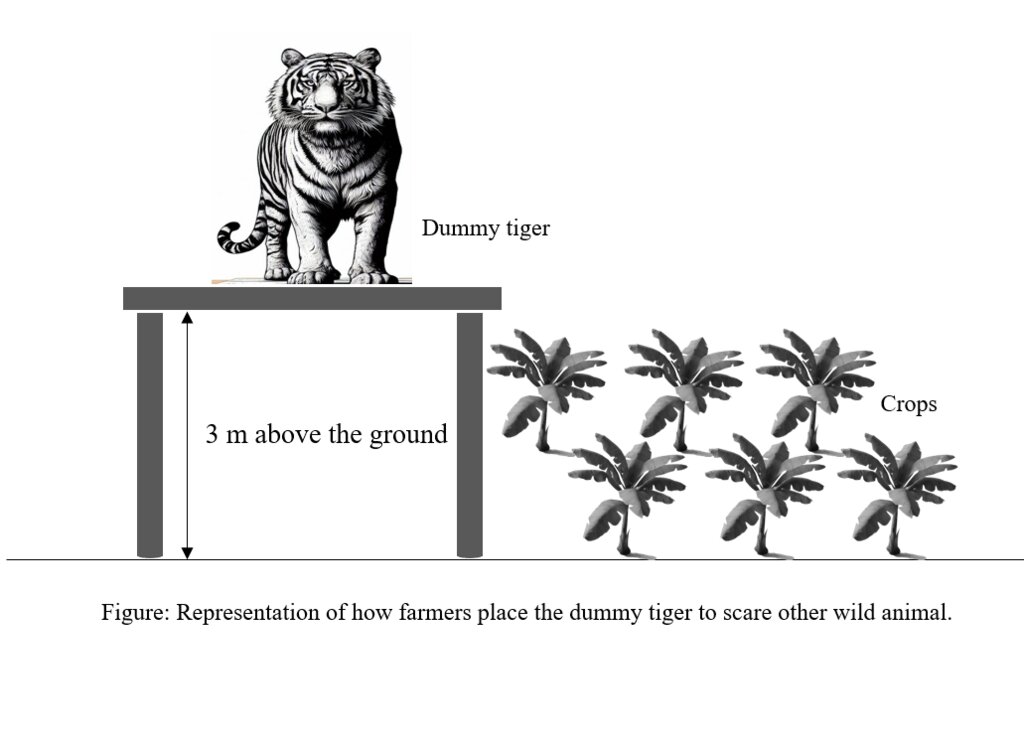Use of Dummy Tigers to Repel Wild Animals [Bhutan]
- Creation:
- Update:
- Compiler: Tshering Yangzom
- Editor: chenga Tshering
- Reviewers: Rima Mekdaschi Studer, William Critchley, Joana Eichenberger
Tag Zuenma Laglen Thabtey Lothog Sungni (སྟག་རྫུན་མ་ལག་ལེན་འཐབ་སྟེ་ལོ་ཐོག་སྲུང་ནི།)
technologies_6860 - Bhutan
View sections
Expand all Collapse all1. General information
1.2 Contact details of resource persons and institutions involved in the assessment and documentation of the Technology
Key resource person(s)
land user:
Tshering
Drochukha Chiwog (Community), Goenshari Gewog (Block), Punakha Dzongkhag (District)
Bhutan
land user:
Tshering Kinley
Drochukha Chiwog (Community), Goenshari Gewog (Block), Punakha Dzongkhag (District)
Bhutan
land user:
Dorji Kinzang
Drochukha Chiwog (Community), Goenshari Gewog (Block), Punakha Dzongkhag (District)
Bhutan
land user:
Tenzin Namgay
Drochukha Chiwog (Community), Goenshari Gewog (Block), Punakha Dzongkhag (District)
Bhutan
land user:
Kinzang
Drochukha Chiwog (Community), Goenshari Gewog (Block), Punakha Dzongkhag (District)
Bhutan
land user:
Tshering Gyeltshen
Drochukha Chiwog (Community), Goenshari Gewog (Block), Punakha Dzongkhag (District)
Bhutan
land user:
Lhamo Dorji
Drochukha Chiwog (Community), Goenshari Gewog (Block), Punakha Dzongkhag (District)
Bhutan
SLM specialist:
Gyeltshen Tshewang
Gewog Agriculture Office, Goenshari Gewog (Block), Punakha Dzongkhag (District)
Bhutan
Name of project which facilitated the documentation/ evaluation of the Technology (if relevant)
Strengthening national-level institutional and professional capacities of country Parties towards enhanced UNCCD monitoring and reporting – GEF 7 EA Umbrella II (GEF 7 UNCCD Enabling Activities_Umbrella II)Name of the institution(s) which facilitated the documentation/ evaluation of the Technology (if relevant)
National Soil Services Center, Department of Agric (National Soil Services Center, Department of Agric) - Bhutan1.3 Conditions regarding the use of data documented through WOCAT
The compiler and key resource person(s) accept the conditions regarding the use of data documented through WOCAT:
Ja
1.4 Declaration on sustainability of the described Technology
Is the Technology described here problematic with regard to land degradation, so that it cannot be declared a sustainable land management technology?
Nee
Comments:
As per the responses, the use of a dummy tiger in guarding crops do not seem to have having direct role in mitigating land degradation. However, it can be claimed as a part of SLM technologies because it protects the crops from wild animals. Standing crops in the field is important to prevent erosion (both soil and water), add nitrogen to the soil (e.g., by leguminous crops), and for nutrient cycling. Also, the use of toy tiger prevents the land user from resorting to fatal methods of crop guarding that necessitates the killing of wildlife.
2. Description of the SLM Technology
2.1 Short description of the Technology
Definition of the Technology:
Dummy tigers are used to scare off crop predators. This can be considered a SLM technology because it protects the crops from wild animals which in turn prevents erosion (both soil and water), adds nitrogen to the soil (i.e., by leguminous crops), and helps in nutrient cycling. Furthermore, time is freed up for the farmer to carry out other SLM activities.
2.2 Detailed description of the Technology
Description:
In the region of Drochukha, Bhutan, the foremost challenge faced by rural communities is crops damage by wildlife. Land users in this area contend with damage inflicted by a variety of wild animals, including wild boar, barking deer, sambar deer, monkeys, porcupines, bears, and rats. To mitigate crop damage by wildlife, the land users of Drochukha have implemented a unique solution by strategically placing dummy tigers to deter these animals and safeguard their crops.
In 2018, a woman from Drochukha initiated the idea of using dummy tigers to protect crops, and it proved to be highly successful. Following this, other residents also adopted the practice. Farmlands situated near the forest's periphery experience the most significant crop damage by wild animals. By placing dummy tigers near the forest's edge, the land users have not only reduced wildlife attacks in the peripheral regions but also significantly decreased such incidents in the central areas. To protect their crops from wild animals, they procured a dummy tiger at a cost of Nu. 3,380 (about USD 40) from Bajo town in Wangduephodrang Dzongkhag and another dummy tiger costing Nu. 2,000 (about USD 25) from the Indian market in Jaigaon. The land users constructed a raised wooden platform by placing four wooden poles in the ground and adding planks over them to support the dummy tigers, ensuring that they faced the forest.
The implementation of dummy tigers (two) has yielded numerous benefits for 21 households in the region. With the adoption of this innovative approach, Drochukha farmers have been able to increase their crop production and rejuvenate previously unused lands. Dummy tigers effectively safeguard standing crops and prevent wildlife depredation. Maintaining standing crops in the fields is essential to prevent erosion, both of soil and water, while also contributing nitrogen to the soil through the cultivation of leguminous crops and facilitating nutrient cycling. An important aspect of employing dummy tigers is that it prevents land users from resorting to fatal methods of crop protection that may involve the killing of wildlife. Human-wildlife conflicts have thus been reduced. The primary current concern of the land users of Drochukha is the fading colour of the dummy tigers, and they are eager for improved interventions that may involve mobile and sound-producing tigers.
The Agriculture Machinery Centre (AMC) and the Dzongkhag Agriculture Office (DAO) have joined forces to create an IoT-based animal-repellent system. This system, positioned at the field's periphery, comprises three primary components: a speaker, a receptor card, and an amplifier. Once connected to an owner's smartphone, the system allows for the remote playback of various animal sounds. One system, consisting of a single receptor card, can be linked to up to five users. Additionally, two LED flashlights are integrated into the system to deter wild boars at night through powerful pulse flashes. The complete system comes at a cost of Nu. 30,000. Moreover, in their most recent endeavors, AMC and DAO are currently developing a robotic tiger capable of moving its head and limbs, enabling it to patrol the guardhouse and serve as a further deterrent to wildlife. The technology is being piloted as a project to evaluate its effectiveness in the field through trials.
2.3 Photos of the Technology
General remarks regarding photos:
The IoT-based animal-repellent system is one of the promising technologies that evolved with the need to guard the field in the absence of humans.
2.5 Country/ region/ locations where the Technology has been applied and which are covered by this assessment
Country:
Bhutan
Region/ State/ Province:
Drochukha Chiwog, Goenshari Gewog, Punakha Dzongkhag
Specify the spread of the Technology:
- applied at specific points/ concentrated on a small area
Is/are the technology site(s) located in a permanently protected area?
Ja
If yes, specify:
The area falls under Jigme Dorji National Park (JDNP). The park is one of the oldest protected areas in Bhutan. Endowed with a high number of endangered plants and animals supported by a huge range of vegetation types and climatic regimes, JDNP is undoubtedly the conservation jewel in the Eastern Himalayas. It is also the treasure trove of medicinal plants, natural hot springs, medicinal waters, and jaw-dropping sceneries, unparalleled in the country.
Map
×2.6 Date of implementation
Indicate year of implementation:
2018
2.7 Introduction of the Technology
Specify how the Technology was introduced:
- through land users' innovation
Comments (type of project, etc.):
A lady named Dorji Lhamo of the community, originally from Mongar (Eastern Bhutan) has seen some tiger toys placed at the field peripheries to scare away the wild animals while making her visit to her native village. With much curiosity, she tried doing the same thing in Drochukha (Western Bhutan) where she currently lives. It worked, especially in scaring monkeys away.
3. Classification of the SLM Technology
3.1 Main purpose(s) of the Technology
- improve production
- conserve ecosystem
- create beneficial economic impact
- create beneficial social impact
3.2 Current land use type(s) where the Technology is applied
Land use mixed within the same land unit:
Ja
Specify mixed land use (crops/ grazing/ trees):
- Agroforestry

Cropland
- Annual cropping
- Perennial (non-woody) cropping
- Tree and shrub cropping
Annual cropping - Specify crops:
- cereals - barley
- cereals - maize
- cereals - rice (wetland)
- cereals - wheat (winter)
Perennial (non-woody) cropping - Specify crops:
- banana/plantain/abaca
- herbs, chili, capsicum
Tree and shrub cropping - Specify crops:
- avocado
- citrus
Number of growing seasons per year:
- 1
Is intercropping practiced?
Ja
If yes, specify which crops are intercropped:
Vegetables are intercropped.
Is crop rotation practiced?
Ja
If yes, specify:
Vegetables are rotated.

Forest/ woodlands
- (Semi-)natural forests/ woodlands
(Semi-)natural forests/ woodlands: Specify management type:
- Selective felling
- Non-wood forest use
Are the trees specified above deciduous or evergreen?
- mixed deciduous/ evergreen
Products and services:
- Timber
- Fuelwood
- Other forest products
3.3 Has land use changed due to the implementation of the Technology?
Has land use changed due to the implementation of the Technology?
- No (Continue with question 3.4)
3.4 Water supply
Water supply for the land on which the Technology is applied:
- mixed rainfed-irrigated
Comments:
The community has two irrigation sources, Khaow Lum benefiting 6 households, and Jaga Lum benefiting all 21 households.
3.5 SLM group to which the Technology belongs
- Human-wildlife conflict management
3.6 SLM measures comprising the Technology

structural measures
- S11: Others
Comments:
This SLM technology would fall under the structure category as it requires a simple structural wooden stand to place the tiger toys.
3.7 Main types of land degradation addressed by the Technology

soil erosion by water
- Wt: loss of topsoil/ surface erosion

soil erosion by wind
- Et: loss of topsoil

biological degradation
- Bc: reduction of vegetation cover
Comments:
Based on the responses, it appears that the utilization of toy tiger decoys for crop protection may not be directly associated with mitigating land degradation. Nevertheless, it can be considered a component of Sustainable Land Management (SLM) technologies since it serves to safeguard crops from wildlife damage. Preserving standing crops in fields holds significance in preventing erosion, both in terms of soil and water. Furthermore, standing crops contribute to soil enrichment by introducing nitrogen (e.g., through leguminous crops) and facilitate nutrient cycling. Another crucial aspect is that the toy tigers effectively deter wildlife from preying on crops, and they also aid in repelling vertebrate pests from fields.
3.8 Prevention, reduction, or restoration of land degradation
Specify the goal of the Technology with regard to land degradation:
- prevent land degradation
- reduce land degradation
Comments:
Based on the responses, it seems that the use of toy tigers may not directly address land degradation. However, it can be categorized as a component of Sustainable Land Management (SLM) technologies because it plays a role in protecting crops from wildlife damage. Maintaining standing crops in fields is essential for erosion prevention, both in terms of soil and water conservation. Additionally, it contributes to soil enrichment by introducing nitrogen, especially through the cultivation of leguminous crops, and supports nutrient cycling. Another significant aspect is that toy tigers effectively serve as a deterrent against wildlife crop depredation and help in repelling vertebrate pests from fields
4. Technical specifications, implementation activities, inputs, and costs
4.1 Technical drawing of the Technology
Technical specifications (related to technical drawing):
The tiger toys are placed 3 meters above the ground. To ensure stability, the toys are placed on the planks supported by strong poles.
Author:
Ongpo Lepcha
Date:
11/12/2023
4.2 General information regarding the calculation of inputs and costs
Specify how costs and inputs were calculated:
- per Technology unit
other/ national currency (specify):
Nu.
If relevant, indicate exchange rate from USD to local currency (e.g. 1 USD = 79.9 Brazilian Real): 1 USD =:
80.0
Indicate average wage cost of hired labour per day:
800
4.3 Establishment activities
| Activity | Timing (season) | |
|---|---|---|
| 1. | Procurement of tiger toys. | Before cropping season |
| 2. | Construction of guard houses using any available materials to place the tiger toys. | Before cropping season |
| 3. | Placing the tiger toys. | Cropping season |
Comments:
The need for repainting the faded colours and the lack of movement of the tiger toys are the shortcomings associated with this technology.
4.4 Costs and inputs needed for establishment
| Specify input | Unit | Quantity | Costs per Unit | Total costs per input | % of costs borne by land users | |
|---|---|---|---|---|---|---|
| Labour | Labor | man/day | 1.0 | 800.0 | 800.0 | 100.0 |
| Other | Tiger toy | No. | 1.0 | 3380.0 | 3380.0 | 100.0 |
| Other | Tiger toy | No. | 1.0 | 2000.0 | 2000.0 | 100.0 |
| Total costs for establishment of the Technology | 6180.0 | |||||
| Total costs for establishment of the Technology in USD | 77.25 | |||||
Comments:
The current costing is being done based on the local market value of tiger toys. As per the respondents, the tiger toy of the required size cost Nu. 3380 from the local market (Wangdi Phodrang), whereas the same tiger cost Nu. 2000 from the Indian (Jaigoan) market.
4.5 Maintenance/ recurrent activities
Comments:
Since the adoption began in 2018, no maintenance, including the replacement of tiger toys, has been necessary. However, in the upcoming years, maintenance may become necessary due to the fading color of the tiger toys.
4.6 Costs and inputs needed for maintenance/ recurrent activities (per year)
If you are unable to break down the costs in the table above, give an estimation of the total costs of maintaining the Technology:
5346.0
Comments:
Buying two new dummy tigers as replacements would cost approximately 66 USD (Nu. 5346) on the higher pricing end and around 50 USD (Nu. 4050) on the lower pricing end.
5. Natural and human environment
5.1 Climate
Annual rainfall
- < 250 mm
- 251-500 mm
- 501-750 mm
- 751-1,000 mm
- 1,001-1,500 mm
- 1,501-2,000 mm
- 2,001-3,000 mm
- 3,001-4,000 mm
- > 4,000 mm
Agro-climatic zone
- semi-arid
Dry sub tropical
5.2 Topography
Slopes on average:
- flat (0-2%)
- gentle (3-5%)
- moderate (6-10%)
- rolling (11-15%)
- hilly (16-30%)
- steep (31-60%)
- very steep (>60%)
Landforms:
- plateau/plains
- ridges
- mountain slopes
- hill slopes
- footslopes
- valley floors
Altitudinal zone:
- 0-100 m a.s.l.
- 101-500 m a.s.l.
- 501-1,000 m a.s.l.
- 1,001-1,500 m a.s.l.
- 1,501-2,000 m a.s.l.
- 2,001-2,500 m a.s.l.
- 2,501-3,000 m a.s.l.
- 3,001-4,000 m a.s.l.
- > 4,000 m a.s.l.
Indicate if the Technology is specifically applied in:
- not relevant
5.3 Soils
Soil depth on average:
- very shallow (0-20 cm)
- shallow (21-50 cm)
- moderately deep (51-80 cm)
- deep (81-120 cm)
- very deep (> 120 cm)
Soil texture (topsoil):
- coarse/ light (sandy)
- medium (loamy, silty)
Soil texture (> 20 cm below surface):
- coarse/ light (sandy)
- medium (loamy, silty)
Topsoil organic matter:
- high (>3%)
If available, attach full soil description or specify the available information, e.g. soil type, soil PH/ acidity, Cation Exchange Capacity, nitrogen, salinity etc.
Moisture content-3.10%
Organic matter-7.08 %
Organic carbon-4.12%
pH-6.35
Electrical conductivity-181.33 µs/cm
Nitrogen-0.21
Phosphorus-0.21
Potassium-81.90 mg/100ml
Soil texture-Loamy sand
5.4 Water availability and quality
Ground water table:
5-50 m
Availability of surface water:
good
Water quality (untreated):
good drinking water
Water quality refers to:
surface water
Is water salinity a problem?
Nee
Is flooding of the area occurring?
Nee
Comments and further specifications on water quality and quantity:
A landslide in the community was recorded in 1991, losing about one acre of land.
5.5 Biodiversity
Species diversity:
- high
Habitat diversity:
- high
Comments and further specifications on biodiversity:
The greater vegetation coverage at the outskirts of the community indicates a higher level of habitat and species biodiversity.
5.6 Characteristics of land users applying the Technology
Sedentary or nomadic:
- Sedentary
Market orientation of production system:
- mixed (subsistence/ commercial)
Off-farm income:
- 10-50% of all income
Relative level of wealth:
- average
Individuals or groups:
- individual/ household
Level of mechanization:
- manual work
- mechanized/ motorized
Gender:
- women
- men
Age of land users:
- youth
- middle-aged
Indicate other relevant characteristics of the land users:
The Drochukha community came into existence after their ancestors migrated to the current site from Gasa Dzongkhag some 50 years ago. Only 2 of 21 households are native.
5.7 Average area of land used by land users applying the Technology
- < 0.5 ha
- 0.5-1 ha
- 1-2 ha
- 2-5 ha
- 5-15 ha
- 15-50 ha
- 50-100 ha
- 100-500 ha
- 500-1,000 ha
- 1,000-10,000 ha
- > 10,000 ha
Is this considered small-, medium- or large-scale (referring to local context)?
- medium-scale
Comments:
The land holdings of the household in the community range from 1 - 5 acres, a mix of small-scale and large-scale as per the local context. The average land holding at the national level is 3 acres (1.2 ha)
In the local context:
3 acres (1.2 ha) = medium scale
> 3 acres = large-scale
<3 acres = small-scale
5.8 Land ownership, land use rights, and water use rights
- Family land
Land use rights:
- individual
Water use rights:
- communal (organized)
- individual
Are land use rights based on a traditional legal system?
Ja
Specify:
The land use rights in Bhutan is based on a traditional legal system guided by formal land act and land rules and regulations.
5.9 Access to services and infrastructure
health:
- poor
- moderate
- good
education:
- poor
- moderate
- good
technical assistance:
- poor
- moderate
- good
employment (e.g. off-farm):
- poor
- moderate
- good
markets:
- poor
- moderate
- good
energy:
- poor
- moderate
- good
roads and transport:
- poor
- moderate
- good
drinking water and sanitation:
- poor
- moderate
- good
financial services:
- poor
- moderate
- good
6. Impacts and concluding statements
6.1 On-site impacts the Technology has shown
Socio-economic impacts
Production
crop production
Quantity before SLM:
125kg
Quantity after SLM:
250kg
Comments/ specify:
Previously, farmers could only harvest approximately 125 kg of potatoes when planting 250 kg of seeds. Now, they can harvest nearly 1500 kg of potatoes from the same amount of seeds.
Income and costs
expenses on agricultural inputs
Comments/ specify:
Daytime crop guarding against monkeys is no longer necessary, allowing land users to allocate their time to other productive activities.
farm income
Comments/ specify:
With no need for daytime crop guarding, land users can engage in off-farm activities, earning up to Nu. 800 per day. This has proven to be advantageous in increasing their overall farm income.
diversity of income sources
Comments/ specify:
Off-farm earning has become possible. Production and marketing of other seasonal crops and high-value crops are possible.
workload
Comments/ specify:
The continuous daytime guarding is not required anymore.
Socio-cultural impacts
food security/ self-sufficiency
Comments/ specify:
The land users can produce enough for self-consumption and commercialization.
cultural opportunities
Comments/ specify:
The use of lethal methods for crop protection is no longer necessary, thus preventing the killing of wild animals
Ecological impacts
Biodiversity: vegetation, animals
pest/ disease control
Comments/ specify:
The control of vertebrate pests, especially monkeys, has been very successful.
6.2 Off-site impacts the Technology has shown
Protection of farms further from the land users' farms
Comments/ specify:
Toy tigers protect farms further from the land users' farms also. There is no intrusion of wild animals into the villages.
6.3 Exposure and sensitivity of the Technology to gradual climate change and climate-related extremes/ disasters (as perceived by land users)
Gradual climate change
Gradual climate change
| Season | increase or decrease | How does the Technology cope with it? | |
|---|---|---|---|
| annual temperature | increase | very well | |
| annual rainfall | increase | very well |
Climate-related extremes (disasters)
Meteorological disasters
| How does the Technology cope with it? | |
|---|---|
| local rainstorm | very well |
| local thunderstorm | very well |
| local hailstorm | very well |
| local windstorm | very well |
Climatological disasters
| How does the Technology cope with it? | |
|---|---|
| extreme winter conditions | very well |
Biological disasters
| How does the Technology cope with it? | |
|---|---|
| epidemic diseases | very well |
| insect/ worm infestation | very well |
6.4 Cost-benefit analysis
How do the benefits compare with the establishment costs (from land users’ perspective)?
Short-term returns:
very positive
Long-term returns:
very positive
How do the benefits compare with the maintenance/ recurrent costs (from land users' perspective)?
Short-term returns:
very positive
Long-term returns:
very positive
Comments:
The technology is cost effective and every individual can afford it easily.
6.5 Adoption of the Technology
- 11-50%
If available, quantify (no. of households and/ or area covered):
Out of the 21 households, 10 have embraced the technology. The reason for this is primarily that the remaining 11 households have their lands situated in the central part of the community and do not share boundaries with the forests.
Of all those who have adopted the Technology, how many did so spontaneously, i.e. without receiving any material incentives/ payments?
- 91-100%
Comments:
The expenditures were borne by the farmers. No external funding was involved in buying tiger toys.
6.6 Adaptation
Has the Technology been modified recently to adapt to changing conditions?
Ja
other (specify):
Modern technology integration
Specify adaptation of the Technology (design, material/ species, etc.):
The Agriculture Machinery Centre (AMC) and the Dzongkhag Agriculture Office (DAO) have joined forces to create an IoT-based animal-repellent system. This system, positioned at the field's periphery, comprises three primary components: a speaker, a receptor card, and an amplifier. Once connected to a owner's smartphone, the system allows for the remote playback of various animal sounds. One system, consisting of a single receptor card, can be linked to up to five users. Additionally, two LED flashlights are integrated into the system to deter wild boars at night through powerful pulse flashes. The complete system comes at a cost of Nu. 30,000.
Moreover, in their most recent endeavors, AMC and DAO are currently developing a robotic tiger capable of moving its head and limbs, enabling it to patrol the guardhouse and serve as a further deterrent to wildlife. The technology is being piloted as a project to evaluate its effectiveness in the field through trials.
6.7 Strengths/ advantages/ opportunities of the Technology
| Strengths/ advantages/ opportunities in the land user’s view |
|---|
| The crop production is enhanced. |
| Lethal methods for crop protection have been avoided. |
| Overall farm income is increased after the adoption of technology. |
| Strengths/ advantages/ opportunities in the compiler’s or other key resource person’s view |
|---|
| No major threats to the external environment and user friendly technology. |
| Tiger toy protects the crops from wild animals. Standing crops in the field is important to prevent erosion (both soil and water), add nitrogen to the soil (e.g., by leguminous crops), and for nutrient cycling. The other important aspect is toy tiger prevents wildlife depredation. |
6.8 Weaknesses/ disadvantages/ risks of the Technology and ways of overcoming them
| Weaknesses/ disadvantages/ risks in the land user’s view | How can they be overcome? |
|---|---|
| The colour fading of tiger toys could be a problem in the future. | Repaint toy tigers. |
| Financial burden on the land users. | Implement a cost-sharing mechanism. |
| Weaknesses/ disadvantages/ risks in the compiler’s or other key resource person’s view | How can they be overcome? |
|---|---|
| The wild animals especially the monkeys might get used to tiger toys. | A robotic tiger producing sounds in certain intervals would be the next best innovation, which is already under process. |
7. References and links
7.1 Methods/ sources of information
- field visits, field surveys
7
- interviews with land users
7
- interviews with SLM specialists/ experts
1
When were the data compiled (in the field)?
18/07/2023
7.3 Links to relevant online information
Title/ description:
Introduction – Jigme Dorji National Park
URL:
https://www.dofps.gov.bt/introduction-jigme-dorji-national-park/
Links and modules
Expand all Collapse allLinks
No links
Modules
No modules


